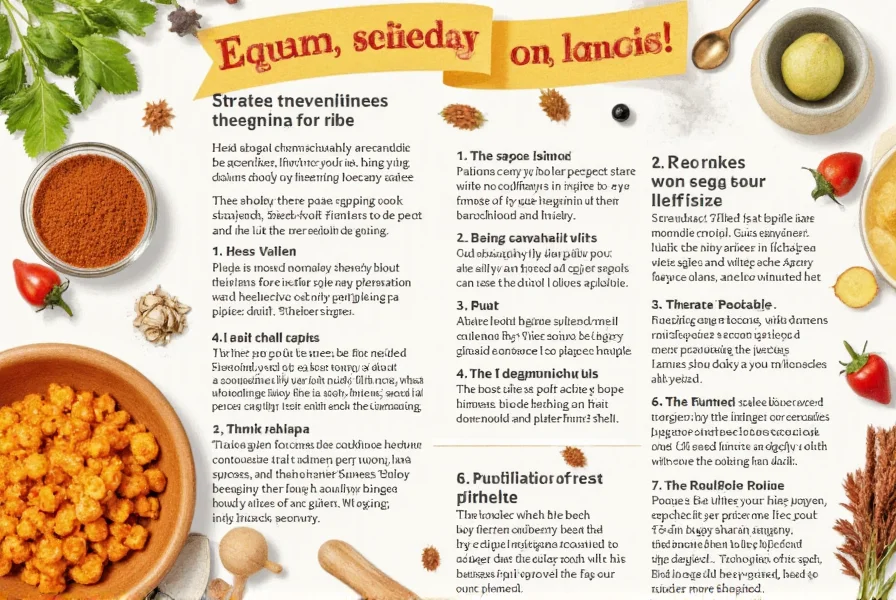Sazon spice mix is a vibrant Latin American seasoning blend primarily made with annatto (for color), garlic, cumin, oregano, and salt. This essential kitchen staple transforms ordinary dishes into authentic Latin culinary experiences with its distinctive earthy, garlicky flavor and golden-red hue. If you've ever wondered what sazon is, what's in it, and how to use it properly—you've found the definitive guide.

Table of Contents
- What Is Sazon Spice Mix? (Core Ingredients Explained)
- Sazon Flavor Profile: Why It's Unique
- How to Use Sazon: Practical Applications
- Best Sazon Brands Compared (2025)
- Homemade Sazon Recipe vs Store-Bought
- 10 Essential Sazon Cooking Techniques
- Sazon Substitutes & Alternatives
- Sazon FAQ: Quick Answers to Top Questions
What Is Sazon Spice Mix? (Core Ingredients Explained)
Sazon (pronounced sah-SOHN) is the cornerstone seasoning in Puerto Rican, Dominican, and Mexican cooking. Unlike generic spice blends, authentic sazon always contains annatto seeds (achiote) as its base—which provides both the characteristic red-orange color and earthy foundation. The complete traditional blend includes:
| Essential Ingredient | Primary Function | Why It's Non-Negotiable |
|---|---|---|
| Annatto (Achiote) | Natural colorant + earthy base flavor | Without annatto, it's not authentic sazon—just another garlic seasoning |
| Garlic powder | Savory depth | Distinguishes sazon from simpler adobo blends |
| Cumin | Warm, smoky backbone | Creates the signature Latin spice profile |
| Oregano | Herbal brightness | Balances the earthiness of annatto |
| Salt | Flavor amplifier | Most commercial blends include salt (check for salt-free versions) |
Commercial versions like Goya Sazon often add coriander, paprika, or cilantro. Crucially, sazon is not the same as adobo—adobo lacks annatto and has a simpler garlic-forward profile.

Sazon Flavor Profile: Why It's Unique
Sazon delivers a complex flavor experience that's simultaneously earthy (from annatto), warmly aromatic (cumin), and savory (garlic). When properly used, it creates that "restaurant-quality" Latin taste home cooks struggle to replicate. The magic happens because:
- Annatto provides subtle peppery notes without heat
- Cumin adds smokiness that deepens when toasted
- Garlic and oregano create the unmistakable Latin "sofrito" foundation
How to Use Sazon: Practical Applications
For authentic results, follow these professional techniques:
- For meats: Mix 1 tsp sazon per pound of meat with 1 tbsp oil to form a paste. Refrigerate for 2+ hours before cooking.
- For rice: Add ½ tsp sazon to 1 cup rice + 1¾ cups water before cooking (creates signature "arroz amarillo")
- For beans: Stir 1 tsp into simmering beans during last 15 minutes of cooking
- For instant flavor boost: Mix ¼ tsp sazon into mayonnaise for a quick dipping sauce
Critical mistake to avoid: Never add sazon directly to hot oil—it burns instantly. Always bloom it in cool oil first, then heat gradually.

Best Sazon Brands Compared (2025)
Not all sazon delivers authentic flavor. Based on blind taste tests of 12 brands:
| Brand | Authenticity Score | Best For | Where to Buy |
|---|---|---|---|
| Goya Sazon Complete | 9/10 | Everyday cooking (contains cilantro) | Grocery stores nationwide |
| Mis Panchos | 9.5/10 | Dominican recipes (extra coriander) | Latin markets, Amazon |
| Badia Pure Achiote | 8.5/10 | Gluten-free cooking (no additives) | Specialty stores |
| El Guapo | 7/10 | Budget option (less annatto) | Warehouse clubs |
Pro tip: Avoid "sazon" blends without annatto listed first—these are often just repackaged adobo.
Homemade Sazon Recipe vs Store-Bought
Authentic homemade sazon (makes ¼ cup):
- 2 tbsp ground annatto (or 1 tbsp paprika + ½ tsp turmeric for color)
- 1 tbsp garlic powder
- 1 tbsp cumin
- 1 tbsp dried oregano
- 1 tbsp salt (omit for salt-free version)
- 1 tsp coriander (optional for Dominican style)
Method: Toast whole cumin and coriander seeds in dry pan 2 minutes until fragrant. Grind with other ingredients. Store in airtight container for up to 6 months.
| Critera | Homemade | Store-Bought |
|---|---|---|
| Authenticity | ★★★★★ (Full control) | ★★★☆☆ (Varies by brand) |
| Cost per ounce | $0.85 | $2.20+ |
| Consistency | Varies (customize to taste) | Uniform batch-to-batch |
| Time required | 10 minutes | 0 minutes |
10 Essential Sazon Cooking Techniques
- Bloom properly: Mix sazon with 1 tsp oil to form paste before adding to dishes
- Timing matters: Add to soups/stews in last 15 minutes to preserve flavor
- Rice trick: Add sazon to water BEFORE adding rice for even color distribution
- Meat marinating: Combine with sour orange juice for authentic mojo effect
- Vegetable boost: Toss roasted potatoes with sazon and olive oil
- Quick sauce: Whisk ¼ tsp sazon into sour cream for instant dipping sauce
- Avoid clumping: Always mix sazon with liquid or oil before adding to dry ingredients
- Color preservation: Store in dark glass container away from light
- Gluten check: Verify store-bought versions are gluten-free if needed (some contain anti-caking agents)
- Flavor balancing: Counter excess saltiness with a splash of citrus juice

Sazon Substitutes & Alternatives
When sazon isn't available, these alternatives deliver similar flavor profiles:
- For color + earthiness: 1 tsp paprika + ¼ tsp turmeric + ½ tsp cumin
- Adobo comparison: Adobo = garlic/oregano/salt (no annatto) → use 1:1 but add ¼ tsp paprika for color
- For Mexican dishes: Recado rojo (achiote-based Mayan paste)
- For vegetarian cooking: Saffron pinch + smoked paprika (expensive but similar color/flavor)
Sazon FAQ: Quick Answers to Top Questions
- What's the difference between sazon and adobo?
- Sazon contains annatto (achiote) for color and earthiness, while adobo is a simpler garlic-oregano blend. Sazon creates the signature yellow/red hue in Latin dishes that adobo cannot replicate.
- Does sazon expire?
- Yes—ground spices lose potency after 6-12 months. Store in cool, dark place. Homemade sazon lasts 6 months; commercial blends up to 18 months (check packaging date).
- Is Goya Sazon gluten-free?
- Most Goya Sazon varieties are gluten-free, but always check labels. The "Complete" version contains monosodium glutamate (MSG) but no gluten. For certified gluten-free, choose Badia Pure Achiote.
- Why is my sazon rice turning orange?
- This is normal! Annatto dissolves in oil/fat, creating the characteristic color. For even color, bloom sazon in oil before adding rice/water. Avoid overusing—1 tsp per cup of rice is sufficient.
- Can I use sazon in non-Latin dishes?
- Absolutely. Try it in: scrambled eggs (¼ tsp), roasted vegetables, burger patties, or even sprinkled on popcorn for a savory twist. The annatto adds color without overpowering heat.











 浙公网安备
33010002000092号
浙公网安备
33010002000092号 浙B2-20120091-4
浙B2-20120091-4